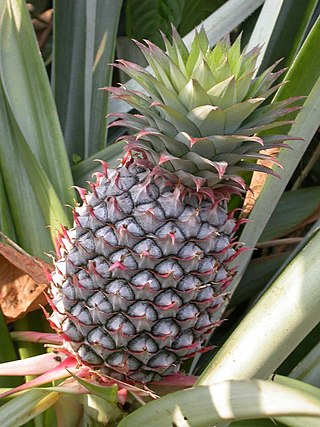
The Bromeliaceae are a family of monocot flowering plants of about 80 genera and 3700 known species, native mainly to the tropical Americas, with several species found in the American subtropics and one in tropical west Africa, Pitcairnia feliciana.
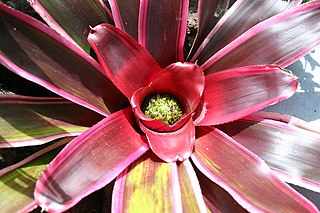
Neoregelia is a genus of epiphytic flowering plants in the family Bromeliaceae, subfamily Bromelioideae, native to South American rainforests. The genus name is for Eduard August von Regel, Director of St. Petersburg Botanic Gardens in Russia (1875–1892).

Vriesea is a genus of flowering plants in the botanical family Bromeliaceae, subfamily Tillandsioideae. The genus name is for Willem Hendrik de Vriese, Dutch botanist, physician (1806–1862). Its species are widespread over Mexico, Central America, South America and the West Indies.
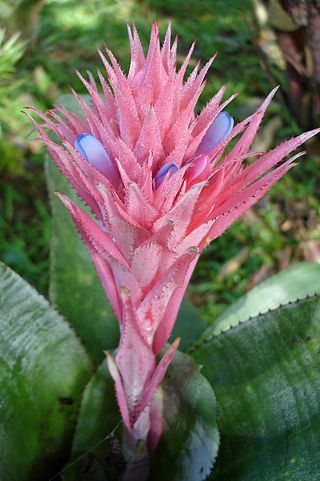
Aechmea is a genus of flowering plants in the family Bromeliaceae. The name comes from the Greek aichme, meaning "spear". Suggested pronunciations include EEK-me-ə and eek-MEE-ə. Aechmea comprises eight subgenera and around 250 species distributed from Mexico through South America and the Caribbean. Most of the species in this genus are epiphytes.

Araeococcus is a genus of the botanical family Bromeliaceae, subfamily Bromelioideae. It is native to northern South America, Central America and Trinidad.

Canistrum is a genus of plants in the family Bromeliaceae, subfamily Bromelioideae.

Cryptanthus is a genus of flowering plants in the family Bromeliaceae, subfamily Bromelioideae. The genus name is from the Greek cryptos (hidden) and anthos (flower). The genus formerly had two recognized subgenera: the type subgenus and subgenus HoplocryptanthusMez which has been raised to the separate genus Hoplocryptanthus. All species of this genus are endemic to Brazil. The common name for any Cryptanthus is "Earth star".

Bromelioideae is a subfamily of the bromeliads (Bromeliaceae). This subfamily is the most diverse, represented by the greatest number of genera with about 40. Most of the plants in this group are epiphytes, though some have evolved in, or will adapt to, terrestrial conditions. This subfamily features the most plant types which are commonly cultivated by people, including the pineapple.

Wittrockia is a genus of plants in the family Bromeliaceae, subfamily Bromelioideae.

Orthophytum is a genus in the plant family Bromeliaceae, subfamily Bromelioideae.
Neoregelia kerryi is a species of flowering plant in the genus Neoregelia. This species is endemic to Brazil. Its name has also been incorrectly spelt Neoregelia kerryae.
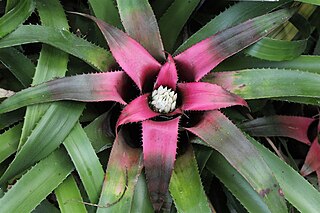
Hylaeaicum is a genus of flowering plant in the family Bromeliaceae, native to tropical northern South America. The taxon was first described by Ernst Heinrich Georg Ule in 1935 as a subgenus of "Aregelia". It was later treated as a subgenus of Neoregelia, before being raised to a full genus in 2021, a status accepted by both Plants of the World Online and the Encyclopaedia of Bromeliads.
Sincoraea navioides is a species of flowering plant in the family Bromeliaceae, native to Brazil. It was first described by Lyman Bradford Smith in 1940 as Cryptanthopsis navioides.
Marcos Henrique Louzada Silva, commonly known as Didi Louzada, is a Brazilian professional basketball player for the Cleveland Charge of the NBA G League. At the 2019 NBA draft, he was drafted by the Atlanta Hawks, before being traded to the New Orleans Pelicans.
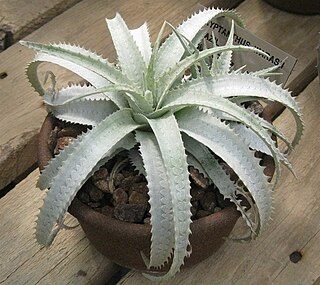
Forzzaea is a genus of eu-bromelioids in the family Bromeliaceae, native to the Atlantic coastal forest of Brazil, and described in 2017.
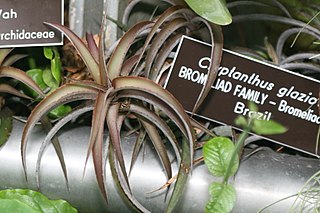
Hoplocryptanthus is a genus of flowering plants belonging to the family Bromeliaceae. It was formerly treated as the subgenus Hoplocryptanthus of the genus Cryptanthus.
Lapanthus is a genus of flowering plants belonging to the family Bromeliaceae.

Rokautskyia is a genus of flowering plant in the family Bromeliaceae, native to eastern Brazil. The genus was first established in 2017, and is placed in subfamily Bromelioideae.

Karawata is a genus of flowering plant in the family Bromeliaceae, native to eastern Brazil. The genus was first described in 2019.
Elton Martinez Carvalho Leme is a Brazilian who is employed as a judge. He is also a self-taught botanist with a special interest in bromeliads. As of November 2022, the International Plant Names Index listed 629 scientific names which include Leme as a publishing author, including 13 generic names.















